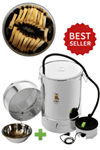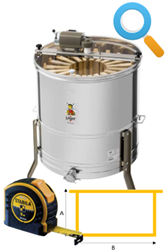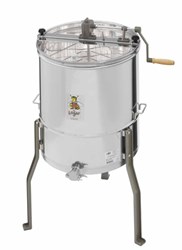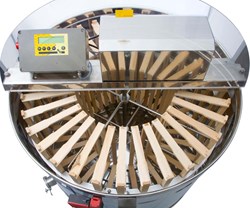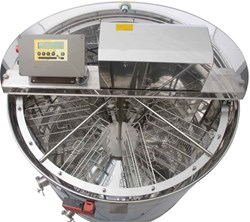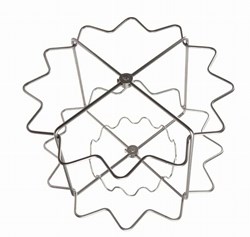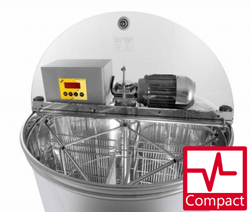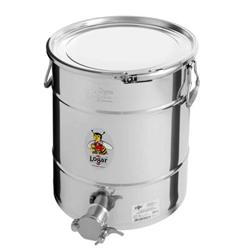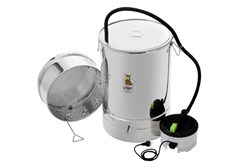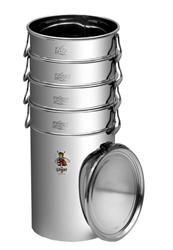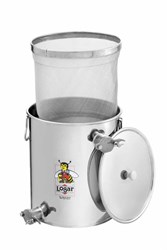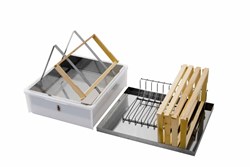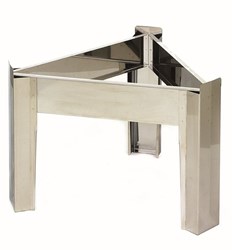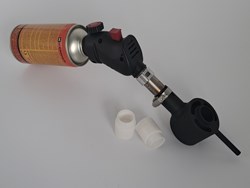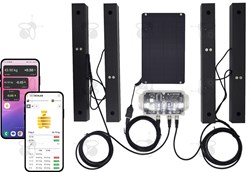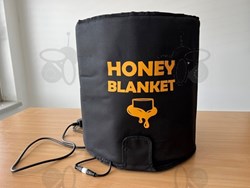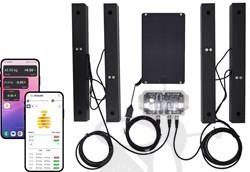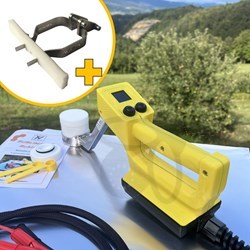Honey extractors, Honey tanks, Wax melters and other Beekeeping equipment of the Logar brand.
Order Online – we deliver to your home. Easy, convenient and safe!
Selected tangential extractors
Selected Radial - honeyextractors
Selected self-turning extractors
Selected best-selling items
Beehive scale for monitoring two beehives
An innovative beehive scale for easy and efficient monitoring of the bee colony's weight.Precise control in the beehive without complicated setups or additional equipment.
The perfect choice for all beekeepers looking for a modern and user-friendly solution to monitor the weight of their bee colonies!
Beehive scale for monitoring two beehives
An innovative beehive scale for easy and efficient monitoring of the bee colony's weight.Precise control in the beehive without complicated setups or additional equipment.
The perfect choice for all beekeepers looking for a modern and user-friendly solution to monitor the weight of their bee colonies!
Beehive scale for monitoring two beehives
1x central unit for monitoring two beehives2x weight sensor
1x solar cell for the power supply
1x weather sensor for measuring weather data (temperature, humidity, air pressure)
Overview of data on the mobile app and on the web portal
With built-in SIM card with 1 year of data transfer.
Resistant to rain and other weather conditions
Cappings wax melter, isolated, diameter 63 cm
-3%
Discovery wax smelter for easy separation of honey from wax lids. This Discovery Wax Melter is particularly suitable for those beekeepers who uncover the honeycombs with the help of Discovery Machines or Electric Discovery Knives, as more honey remains in the honeycomb lids in these discoveries. It can also be used to liquefy honey in jars or smaller containers.
Bee corridor to prevent bee robbery
Tested effectiveness for preventing bee robbing. It is inserted in the entrance of the beehive at the time of bee robbing dangerBee corridor to prevent bee robbery
Tested effectiveness for preventing bee robbing. It is inserted in the entrance of the beehive at the time of bee robbing danger
Honey Blanket - Heizmantel für Honig
-23%
Isolierter Heizmantel zum Erwärmen von Honig, dient als Unterstützung zum Abfüllen oder Rühren.
Bundle: 3 stackable storage tanks 35 kg with airtight lid, stainless steel (-5% Discount)
-5%
- Stackable storage tank 35 kg with airtight lid, stainless steel
Wax melter/disinfection pan 100 l, with steam generator, stainless steel
-3%
The small wax melter is suitable for hobby beekeepers and is intended for the melting of old honeycombs and uncapping wax and also for disinfecting the beekeeping tool, the equipment and the frames. A melting process for about 10-12 Zander or DNM frames (the number depends on the size of the frames) takes about 30 minutes.
Overview of all honey extractors depending on type and drive
Tangential honey extractors
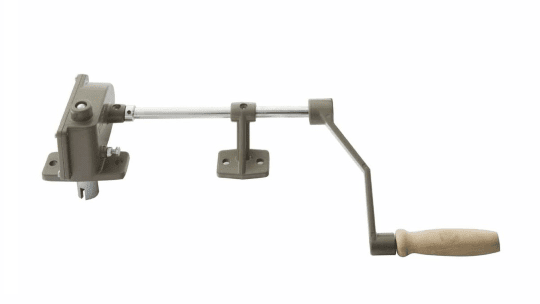
Tangential honey extractors - Manual
- 4005 - 3-Frames-Extractor, tangential, manual, barrel 40 cm, frames 26,5 x 48 cm
- 4006 - 3-Frames-Extractor, tangential, manual, barrel 52 cm, frames 37 x 48 cm, universal
- 4105 - 4-Frames-Extractor, tangential, manual, barrel 52 cm, frames 30 x 48 cm
- 4108 - 4-Frames-Extractor, manual, barrel 52 cm, without going through middle axle, frames 30 x 48 cm
- 4120 - 4-Frames-Extractor, tangential, manual, barrel 63 cm, frames 37 x 48 cm, universal
- 4122 - 4-Frames-Extractor, manual, barrel 63 cm, without going through middle axle, frames 37 x 48 cm, universal
- 4111 - Logar 4-Waben Honigschleuder, Handantrieb mit Siebkanne, 30x48, Kessel Durchmesser 52 cm
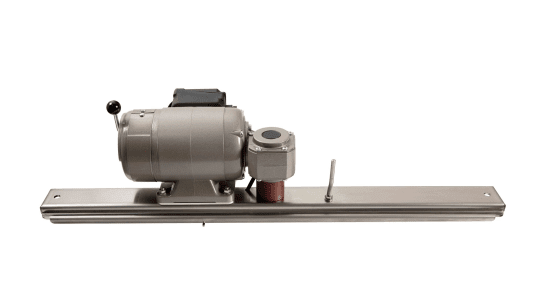
Tangential honey extractors - Motor drive
- 4104 - 4-Frames-Extractor, tangential, motor 110W, barrel 52 cm, frames 30 x 48 cm
- 4007 - 3-Frames-Extractor, tangential, motor 110W, barrel 52 cm, frames 37 x 48 cm, universal
- 4107 - 4-Frames-Extractor, motor 110W, barrel 52 cm, without going through middle axle, frames 30 x 48 cm
- 4121 - 4-Frames-Extractor, tangential, motor 110W, barrel 63 cm, frames 37 x 48 cm, universal
- 4123 - 4-Frames-Extractor, motor 110W, barrel 63 cm, without going through middle axle, frames 37 x 48 cm, universal
- 4110 - Logar 4-Waben Honigschleuder, Motorantrieb mit Siebkanne, 30x48, Kessel Durchmesser 52 cm
- 4200 - Extractor 4F self-turning,motor 110W, barrel 76
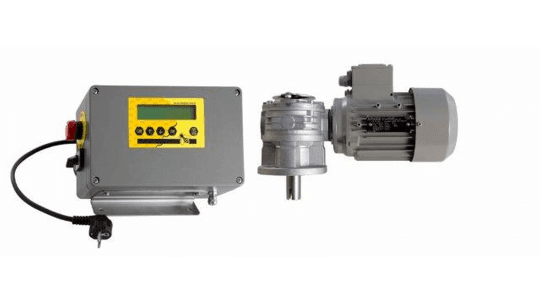
Tangential honey extractors - Automatic drive
Radial honey extractors

Radial honey extractors - Manual

Radial honey extractors - Motor drive
- 4541 - 9-Frames Radial extractor, motor 110W, barrel 52 cm, frames 18 x 48 cm
- 4551-Z - 12 Frames Radial extractor, motor 110W, barrel 63 cm, Zander
- 4551 - 12/8-Frames Radial extractor, motor 110W, barrel 63 cm
- 4557 - 20/8-Frames Radial extractor, motor 110W, barrel 63 cm + 4 tangential screens
- 4560 - 24/12-Frames Radial extractor, motor 110W, barrel 76 cm
- 4559 - 12-Frames Radial extractor with grids, motor 110W, barrel 76 cm

Radial honey extractors - Automatic drive
- 4551A - Logar 12/8-Waben-Radialschleuder, Kessel 63 cm, Vollautomatik Antrieb, Motor 110W, Rähmchen 24 x 48 cm
- 4551ACH1 - 12-Waben-Radialschleuder für Schweizer Honigrahmen, Kessel 63 cm, 110W Motor, Vollautomatik Antrieb
- 4551ACH1 - 12-Waben-Radialschleuder für Schweizer Honigrahmen, Kessel 63 cm, 110W Motor, Vollautomatik Antrieb
- 4555 - Logar 20/8-Frame-Radialextractor, Barrel 63 cm, fully automatic drive, Motor110W, frames 24 x 48 cm + 4 Tangential screens
- 4553 - 12/8-Frames Radial extractor, motor 110W, barrel 63 cm
- 4561 - 24/12-Frames Radial extractor, programautomatic, barrel 76 cm, 180W
- 4580 - 12-Frames Radial extractor with grids, programautomatic, barrel 76 cm
- 4572 - 40/16-Frames Radial extractor, programautomatic, barrel 95 cm, 370W
- 4570 - 32-Frames Radial extractor, programautomatic, barrel 95 cm, 370W
- 4573 - 48-Frames Radial extractor, programautomatic, barrel 110 cm, 750W
Self-turning honey extractors

Self-turning honey extractors - Motor drive

Self-turning honey extractors - Automatic drive
- 4206 - 4-Frames Self-turning extractor, programautomatic, 23 x 48 cm, barrel 63 cm,110W-M
- 4506 - 4-Frames Self-turning extractor, programautomatic, 23 x 48 cm, barrel 63 cm,110W-M
- 4201 - 4-Frames Self-turning extractor, 180W motor, programautomatic, barrel 76 cm, frames 26,5 x 48 cm
- 4204 - 4-Frames Self-turning extractor, 180W motor, programautomatic, barrel 76 cm, frames 28,6 x 48 cm
- 4302 - 6-Frames Self-turning extractor, motor 180W, programautomatic, frames 23 x 48 cm
- 4306 - 6-Frames Self-turning extractor, motor 180W, programautomatic, frames 26,5 x 48 cm
- 4208 - 4-Frames Self-turning extractor, 180W motor, programautomatic, barrel 76 cm, frames 28,6 x 48 cm
- 4300 - 6-Frames Self-turning extractor, motor 250W, programautomatic, barrel 82 cm, frames 26,5 x 48 cm
- 4401 - 8-Frames Self-turning extractor, motor 250W, programautomatic, barrel 82 cm, frames 23 x 48 cm
- 4304 - 6/12-Frames Self-turning extractor, motor 370W, programautomatic, barrel 95 cm, frames 34 x 48 cm
- 4400 - 8-Frames Self-turning extractor, motor 370W, programautomatic, barrel 95 cm, frames 26,5 x 48 cm
Honey extractors
 We are pleased to present honey extractors from the Logar brand, high-quality products of the Logar Trade company from Slovenia. Honey extractors are carefully developed and manufactured from high-quality polished stainless steel that provides sustainability and a long service life. All components which come into contact with honey are made of tested and certified materials suitable for food contact.
We are pleased to present honey extractors from the Logar brand, high-quality products of the Logar Trade company from Slovenia. Honey extractors are carefully developed and manufactured from high-quality polished stainless steel that provides sustainability and a long service life. All components which come into contact with honey are made of tested and certified materials suitable for food contact.
- All motorised honey extractors have the CE marking.
- Due to their superior quality and reliability, Logar honey extractors are popular among beekeepers throughout Europe.
Do you need a honey extractor, but aren’t sure which one to choose?
Use our Configurator to pick your suitable honey extractor! Enter frame dimensions or simply select the type of your frames.
- They are particularly suitable for amateur beekeepers.
- In extracting honey, the frame is placed tangentially to the tub so the honey drains more easily.
- Tangential honey extractors allow the extraction from large frames, and are thus considered the most universal honey extractors.
- They are an excellent solution for beekeepers who want to extract honey of low to medium viscosity.
- Centrifugal force and the natural tendency of cells ensure that both sides of the comb are simultaneously extracted, so there is no need for turning the combs.
- Radial honey extractors are available in manually operated and motorised versions.
- All radical honey extractors are available with a heated bottom which is comes handy in several-days-long extraction or cleaning of the extractor
Automatically revolving honey extractors
- They are particularly suitable for beekeepers who extract honey with high viscosity.
- Their advantage lies in the fact that they revolve the combs automatically during extraction.
- This type of extractors have stationary honey chamber boxes always facing the axis, and by rotating the basket they turn tangentially to the tub. The wire grid chamber box prevents the honey from congesting he chamber box and thus the combs are dry after extraction.
- All automatically revolving honey extractors are available with a heated bottom which comes handy in several-days-long extraction or cleaning of the extractor.
Honey filling containers, honey pails, honey storage containers and straining pots made of stainless steel
All the listed containers are made entirely of rust-resistant materials, are suitable for food contact and have a seamlessly welded bottom and are thus easy to clean.
 Honey filling containers with a drain tap (25 - 170 kg)
Honey filling containers with a drain tap (25 - 170 kg)
They are suitable for direct filling into glass containers. The stainless drain tap is welded to the container and nicely cuts the honey during filling into glass containers without any mess.
Honey storage container (25 - 280 kg)
Honey storage containers have no drain tap. They include a silicone gasket in the lid and a rust-resistant clamping collar which provide airtight sealing.
Honey pails have a slightly conical shape which allows you to stack them one into another (max. three) resulting in better use of space.
A straining pot is intended for straining honey during extraction.
We have tried all combinations of strainers and straining pots and recommend a combination of coarse strainer and the straining pot, item no. 2561. As this combination works best, we recommend that you purchase these two products. Even if you strain honey the whole day long, the strainer net will not clog up, which saves you a lot of time and worry
Wax melters
Beekeepers use wax melters to melt old wax from frames. The melter melts the wax by using water steam, whereby pure beeswax is extracted and poured through the perforated bottom of the melter and into the external container. The rest of the wax is collected in a perforated basket. During the melting process, the frames are thoroughly cleaned and disinfected and are then ready to be used again.
- We recommend that amateur beekeepers who want to get rid of old wax from their frames in a quick and efficient way use the melter
- Approximately 15 frames can be inserted into the perforated basket of the melter, depending on their size
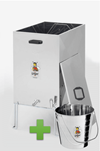 Large wax extractor with a gas heater
Large wax extractor with a gas heater
- A large extractor for beekeepers who keep 20–100 bee colonies
Comb uncapping containers
A comb uncapping container with a surface for putting down combs is a very practical and welcome solution for every beekeeper since it offers a large surface for smooth operation while protecting your work surface against honey and wax at the same time.
The container has a perforated rust-resistant insert that facilitates the straining of cappings.
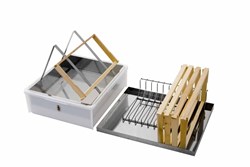 An uncapping tub comes very handy in straining honey and also offers enough space for opened wax cappings. It is also provided with a perforated insert for straining the cappings.
An uncapping tub comes very handy in straining honey and also offers enough space for opened wax cappings. It is also provided with a perforated insert for straining the cappings.- A rust-resistant drain tap for honey draining is integrated at the lowest central point of the bottom.
- There is an edge on both short sides of the tub with the purpose of scraping burr combs or uncapping fork.
Uncapping tub with a worktop (125cm)
- An uncapping tub with a worktop protects your work surface from honey and wax dripping.
- Place the comb you want to uncap on the tub girders.
- The tub has casters and a lid made of stainless steel.
- 5 height levels
Beehive scale
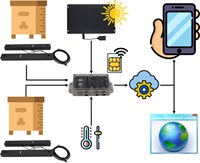 The BeeScales.io beehive scale allows you to remotely control two beehives at once. BeeScales.io operates with a SIM card and thus enables you to check the situation in your beehives at any time through a mobile application. Advantages of the scale:
The BeeScales.io beehive scale allows you to remotely control two beehives at once. BeeScales.io operates with a SIM card and thus enables you to check the situation in your beehives at any time through a mobile application. Advantages of the scale:
- Measurements are carried out each hour
- Cloud-based data storage
- Web portal and mobile application available
- Integrated SIM card with free data transfer for the first year
- Possibility of using your own SIM card
- Solar cell allows unlimited use
- Easy to use
- Security against theft
- Geolocation to monitor the location of the scale
Bee corridor for preventing a bee robbery
When there is a shortage of nectar sources in nature, there is a possibility that bees attack food reserves in the combs of weaker bee colonies. This is called a bee robbery which decimates the population of the bee colony, since the bees run out of food, and at the same time it can affect robber bees, which can catch and bring numerous diseases together with the food to their hives. Bee robbery can be prevented by using a bee corridor which is inserted into the beehive entrance
- The bee corridor effectively prevents bee robberies
- It is inserted in the beehive entrance and protects the bee colony
- It significantly reduces the power of robber bees and increases the defensive ability of guard bees
- The bee corridor is inserted in the entrance when the nectar sources are low or towards the end of honey flow period.
- It is also suitable for weaker bee colonies

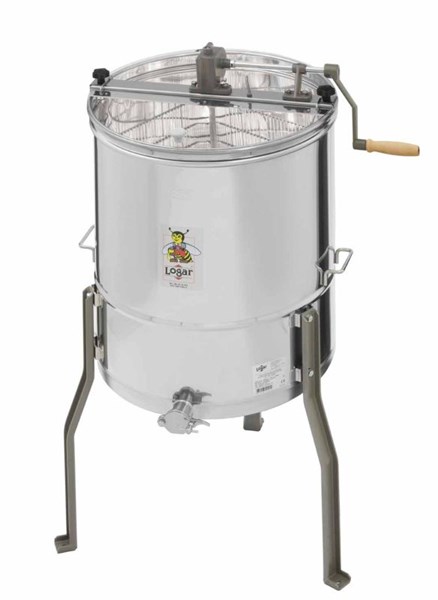




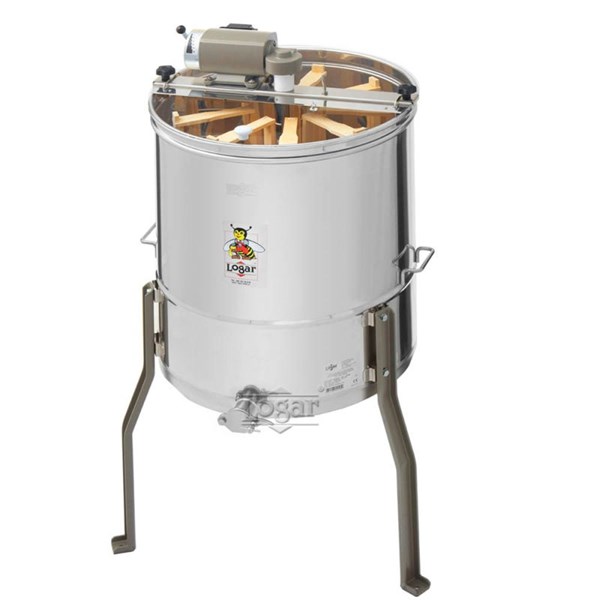




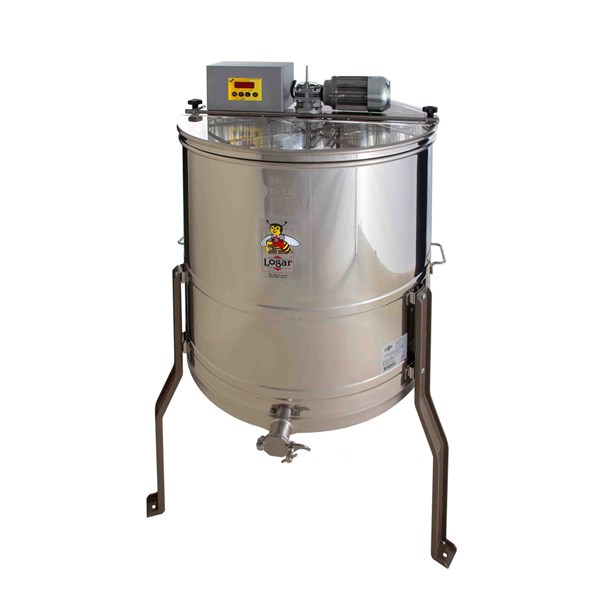





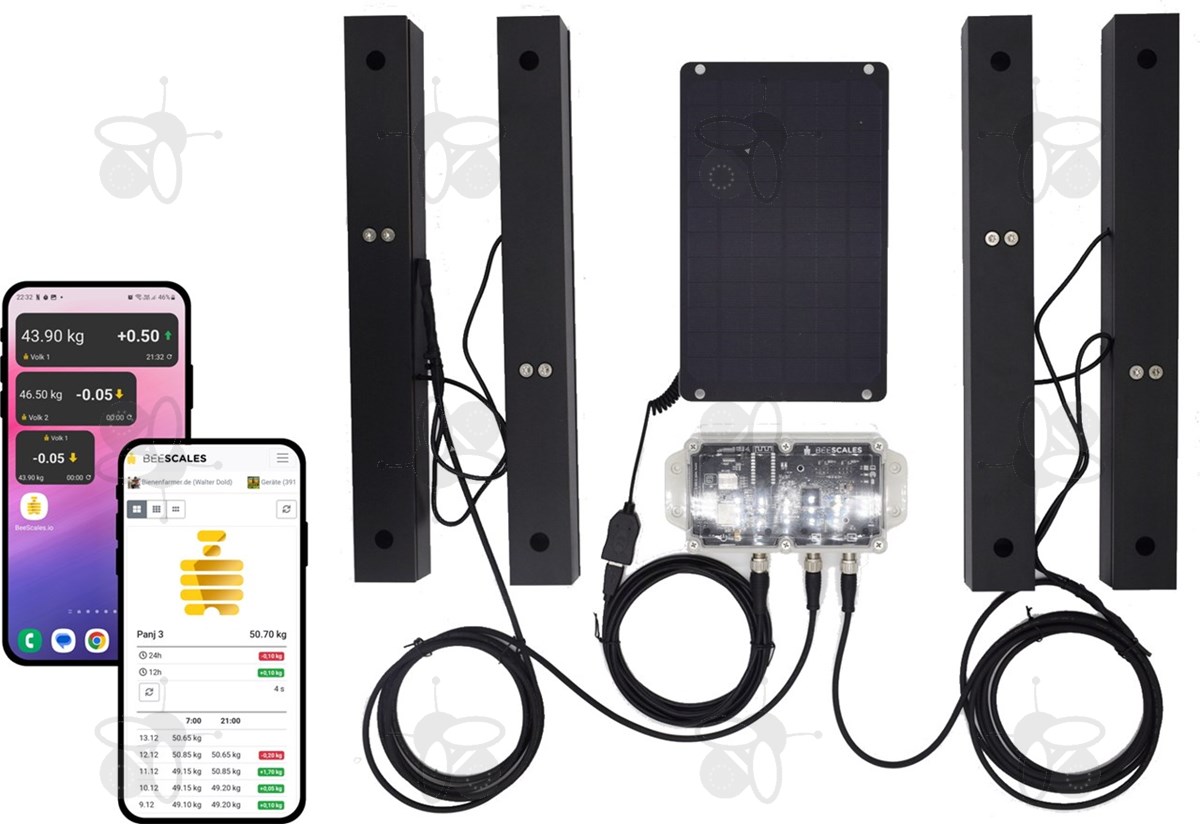

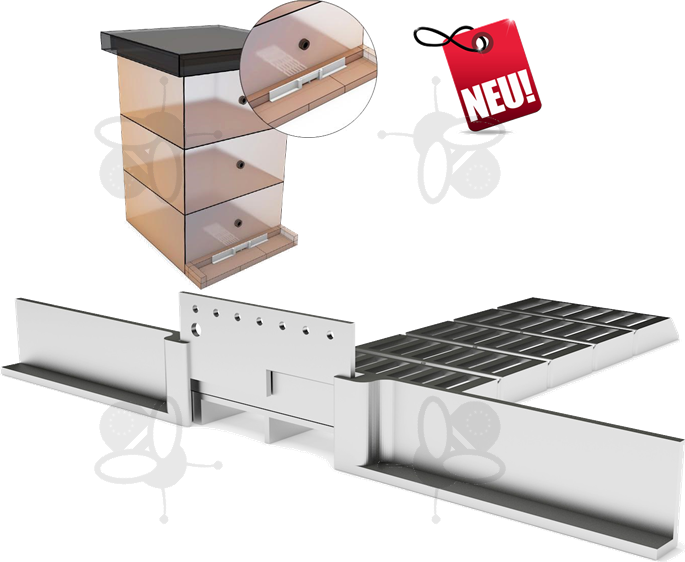




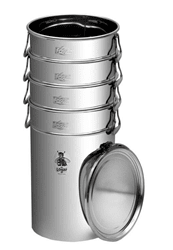 Honey pails
Honey pails 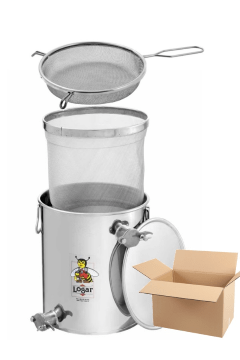 Straining pots
Straining pots